The Warning: Windows Has Detected a Malicious Virus On Your System is classified as misleading ‘ad’ web page. This web site is made to trick you into calling the fake Microsoft Support Service. It can show misleading popup alerts within the Chrome, FF, Microsoft Edge and IE or redirect your browser on other malicious and questiobale web-sites. If you’re seeing the “Windows Has Detected a Malicious Virus” popup scam then most probably that your internet browser is affected with an ‘ad-supported’ software (also known as adware). As a result of the adware infection, your browser will be full of advertisements (pop-ups, banners, in-text links, offers to install an unwanted apps) and your system will be slower and slower.
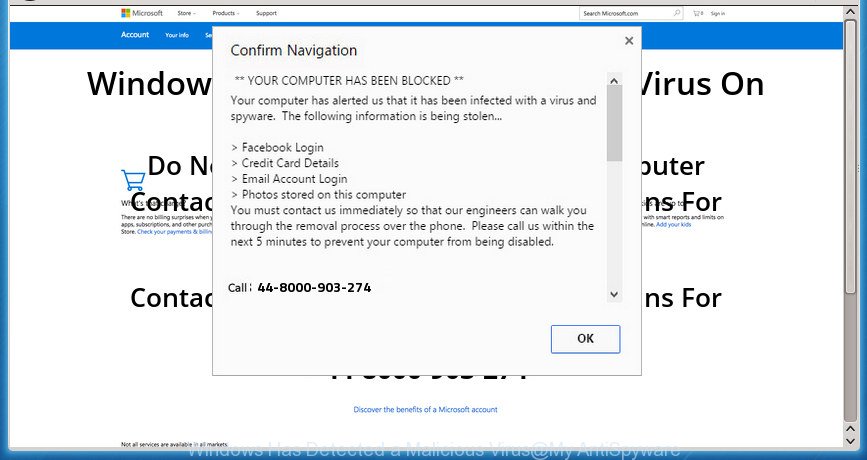
“Windows Has Detected a Malicious Virus” is a misleading advertising
The ad supported software that causes multiple misleading “Windows Has Detected a Malicious Virus” alerts and popups, is the part of the software that is used as an online promotional tool. It is created with the sole purpose to show dozens of ads, and thus to promote the goods and services in an open internet browser window. Moreover, the adware can substitute the legitimate advertising banners on misleading or even banners that can offer to visit harmful web-pages. The reason is simple, many advertisers agree on any ways to attract users to their web-sites, so the creators of ‘ad supported’ software, often forcing users to click on an advertising link. For each click on a link, the developers of the adware receive income.
The malicious programs from the adware family that modifies the settings of web browsers usually affects only the Chrome, FF, Internet Explorer and Microsoft Edge. However, possible situations, when any other web-browsers will be affected too. The adware may alter the Target property of a web browser’s shortcut, so every time you start the web-browser, instead of your start page, you will see the intrusive “Windows Has Detected a Malicious Virus” page.
Thus, it is clear that the presence of adware on your computer is not desirable, and you need to clean up your personal computer as soon as possible. Follow the steps below in order to remove “Windows Has Detected a Malicious Virus” fake alerts.
Remove “Windows Has Detected a Malicious Virus” popup warnings
The ‘ad supported’ software is a form of malicious software that you might have difficulty in removing it from your machine. Thankfully, you’ve found the effective “Windows Has Detected a Malicious Virus” fake alerts removal instructions in this article. Both the manual removal way and the automatic removal solution will be provided below and you can just select the one that best for you. If you have any questions or need help then type a comment below. Read it once, after doing so, please print this page as you may need to shut down your web browser or reboot your system.
To remove “Windows Has Detected a Malicious Virus”, perform the following steps:
- How to manually remove “Windows Has Detected a Malicious Virus”
- Removing the “Windows Has Detected a Malicious Virus”, check the list of installed apps first
- Remove unwanted Scheduled Tasks
- Fix affected web-browsers shortcuts to remove “Windows Has Detected a Malicious Virus” redirect
- Delete “Windows Has Detected a Malicious Virus” from Firefox by resetting browser settings
- Remove “Windows Has Detected a Malicious Virus” pop-up warnings from Internet Explorer
- Remove “Windows Has Detected a Malicious Virus” fake alerts from Chrome
- Run free malware removal tools to completely remove “Windows Has Detected a Malicious Virus” fake alerts
- Run AdBlocker to stop “Windows Has Detected a Malicious Virus” and stay safe online
- Where the “Windows Has Detected a Malicious Virus” popup comes from
- Finish words
How to manually remove “Windows Has Detected a Malicious Virus”
The step by step guide will help you delete “Windows Has Detected a Malicious Virus” fake alerts. These “Windows Has Detected a Malicious Virus” removal steps work for the Chrome, Internet Explorer, FF and MS Edge, as well as every version of Windows operating system.
Removing the “Windows Has Detected a Malicious Virus”, check the list of installed apps first
In order to remove potentially unwanted programs like this adware, open the Microsoft Windows Control Panel and click on “Uninstall a program”. Check the list of installed software. For the ones you do not know, run an Internet search to see if they are adware, browser hijacker or potentially unwanted programs. If yes, remove them off. Even if they are just a applications which you do not use, then removing them off will increase your machine start up time and speed dramatically.
Windows 10, 8.1, 8
Click the Microsoft Windows logo, and then click Search ![]() . Type ‘Control panel’and press Enter as shown on the screen below.
. Type ‘Control panel’and press Enter as shown on the screen below.

After the ‘Control Panel’ opens, press the ‘Uninstall a program’ link under Programs category as shown on the screen below.

Windows 7, Vista, XP
Open Start menu and select the ‘Control Panel’ at right as shown in the figure below.

Then go to ‘Add/Remove Programs’ or ‘Uninstall a program’ ({Windows} 7 or Vista) as shown on the image below.

Carefully browse through the list of installed apps and remove all suspicious and unknown programs. We recommend to click ‘Installed programs’ and even sorts all installed software by date. After you have found anything suspicious that may be the adware, ad-supported software or potentially unwanted apps, then select this program and press ‘Uninstall’ in the upper part of the window. If the questionable program blocked from removal, then run Revo Uninstaller Freeware to fully remove it from your PC.
Remove unwanted Scheduled Tasks
Once installed, the ‘ad supported’ software can add a task in to the Windows Task Scheduler Library. Due to this, every time when you start your computer, it will open “Windows Has Detected a Malicious Virus” intrusive web site. So, you need to check the Task Scheduler Library and remove all malicious tasks that have been created by malicious application.
Press Windows and R keys on the keyboard simultaneously. This opens a dialog box that titled as Run. In the text field, type “taskschd.msc” (without the quotes) and click OK. Task Scheduler window opens. In the left-hand side, click “Task Scheduler Library”, like below.
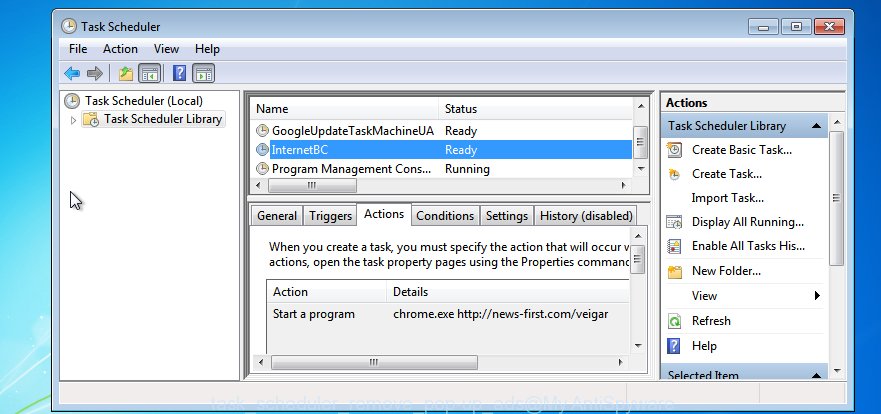
Task scheduler
In the middle part you will see a list of installed tasks. Please select the first task, its properties will be show just below automatically. Next, click the Actions tab. Pay attention to that it launches on your PC. Found something like “explorer.exe http://site.address” or “chrome.exe http://site.address”, then get rid of this harmful task. If you are not sure that executes the task, check it through a search engine. If it is a component of the adware, then this task also should be removed.
Having defined the task that you want to remove, then press on it with the right mouse button and select Delete as shown on the screen below.

Delete a task
Repeat this step, if you have found a few tasks which have been created by unwanted software. Once is finished, close the Task Scheduler window.
Fix affected web-browsers shortcuts to remove “Windows Has Detected a Malicious Virus” redirect
Important to know, most antimalware apps that are able to delete ‘ad supported’ software which made to show misleading “Windows Has Detected a Malicious Virus” fake alerts within your web browser, but unable to detect and recover modified shortcuts. So, you need to fix the desktop shortcuts for your Google Chrome, Firefox, Microsoft Edge and Microsoft Internet Explorer internet browsers manually.
Open the properties of the browser shortcut. Right click on the shortcut file of affected internet browser and select the “Properties” option and it will show the properties of the shortcut file. Next, choose the “Shortcut” tab and have a look at the Target field as shown in the figure below.
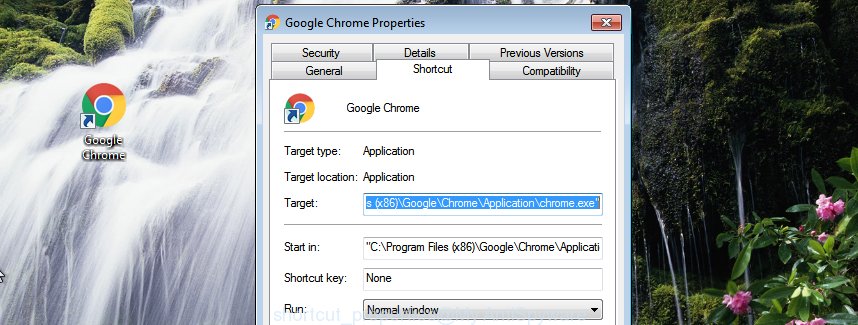
Normally, if the last word in the Target field is chrome.exe, iexplore.exe, firefox.exe. Be sure to pay attention to the extension, should be “exe”! All shortcuts that have been changed by ‘ad supported’ software that shows misleading “Windows Has Detected a Malicious Virus” fake alerts on your computer, usually point to .bat, .cmd or .url files instead of .exe like below

Another variant, an address has been added at the end of the line. In this case the Target field looks like …Application\chrome.exe” http://site.address as on the image below.

In order to fix the affected shortcut, you need to insert right path to the Target field or remove an address (if it has been added at the end). You can use the following information to fix your shortcut files that have been changed by adware which created to show misleading “Windows Has Detected a Malicious Virus” popup warnings within your internet browser.
| Google Chrome | C:\Program Files (x86)\Google\Chrome\Application\chrome.exe |
| C:\Program Files\Google\Chrome\Application\chrome.exe | |
| Mozilla Firefox | C:\Program Files\Mozilla Firefox\firefox.exe |
| Microsoft Internet Explorer | C:\Program Files (x86)\Internet Explorer\iexplore.exe |
| C:\Program Files\Internet Explorer\iexplore.exe | |
| Opera | C:\Program Files (x86)\Opera\launcher.exe |
| C:\Program Files\Opera\launcher.exe |
Once is finished, click OK to save changes. Repeat the step for all browsers that are re-directed to the “Windows Has Detected a Malicious Virus” unwanted web-site.
Delete “Windows Has Detected a Malicious Virus” from Firefox by resetting browser settings
The FF reset will keep your personal information such as bookmarks, passwords, web form auto-fill data, recover preferences and security settings, remove redirects to undesired “Windows Has Detected a Malicious Virus” web site and ‘ad supported’ software.
First, launch the Firefox and click ![]() button. It will display the drop-down menu on the right-part of the browser. Further, press the Help button (
button. It will display the drop-down menu on the right-part of the browser. Further, press the Help button (![]() ) as displayed in the figure below
) as displayed in the figure below
.

In the Help menu, select the “Troubleshooting Information” option. Another way to open the “Troubleshooting Information” screen – type “about:support” in the web browser adress bar and press Enter. It will open the “Troubleshooting Information” page like below. In the upper-right corner of this screen, click the “Refresh Firefox” button.

It will display the confirmation dialog box. Further, click the “Refresh Firefox” button. The Firefox will begin a process to fix your problems that caused by the ad supported software that designed to display misleading “Windows Has Detected a Malicious Virus” pop-up within your web-browser. Once, it’s finished, click the “Finish” button.
Remove “Windows Has Detected a Malicious Virus” pop-up warnings from Internet Explorer
By resetting Microsoft Internet Explorer web-browser you restore your web-browser settings to its default state. This is good initial when troubleshooting problems that might have been caused by ad supported software that created to display misleading “Windows Has Detected a Malicious Virus” popup within your web-browser.
First, open the Internet Explorer, then click ‘gear’ icon ![]() . It will display the Tools drop-down menu on the right part of the web browser, then press the “Internet Options” as shown on the image below.
. It will display the Tools drop-down menu on the right part of the web browser, then press the “Internet Options” as shown on the image below.

In the “Internet Options” screen, select the “Advanced” tab, then click the “Reset” button. The IE will display the “Reset Internet Explorer settings” dialog box. Further, press the “Delete personal settings” check box to select it. Next, click the “Reset” button as shown in the figure below.

Once the procedure is done, click “Close” button. Close the Internet Explorer and reboot your PC system for the changes to take effect. This step will help you to restore your browser’s home page, newtab page and search engine by default to default state.
Remove “Windows Has Detected a Malicious Virus” fake alerts from Chrome
Use the Reset web-browser utility of the Google Chrome to reset all its settings like startpage, new tab page and search engine by default to original defaults. This is a very useful tool to use, in the case of internet browser redirects to undesired ad web pages such as “Windows Has Detected a Malicious Virus”.
Open the Chrome menu by clicking on the button in the form of three horizontal dotes (![]() ). It will show the drop-down menu. Choose More Tools, then click Extensions.
). It will show the drop-down menu. Choose More Tools, then click Extensions.
Carefully browse through the list of installed addons. If the list has the plugin labeled with “Installed by enterprise policy” or “Installed by your administrator”, then complete the following tutorial: Remove Chrome extensions installed by enterprise policy otherwise, just go to the step below.
Open the Google Chrome main menu again, click to “Settings” option.

Scroll down to the bottom of the page and click on the “Advanced” link. Now scroll down until the Reset settings section is visible, as shown on the image below and press the “Reset settings to their original defaults” button.

Confirm your action, click the “Reset” button.
Run free malware removal tools to completely remove “Windows Has Detected a Malicious Virus” fake alerts
Many antivirus companies have developed software that help detect ‘ad supported’ software and thereby delete “Windows Has Detected a Malicious Virus” from the Chrome, IE, Mozilla Firefox and MS Edge browsers. Below is a a few of the free programs you may want to use. Your computer may have a large count of PUPs, ‘ad supported’ software and hijackers installed at the same time, so we suggest, if any unwanted or malicious program returns after restarting the machine, then start your personal computer into Safe Mode and run the anti malware utility again.
Automatically remove “Windows Has Detected a Malicious Virus” fake alerts with Zemana Anti-malware
Zemana Anti-malware is a tool which can remove adware, potentially unwanted apps, browser hijackers and other malicious software from your PC system easily and for free. Zemana Anti-malware is compatible with most antivirus software. It works under Windows (10 – XP, 32 and 64 bit) and uses minimum of computer resources.

- Please go to the following link to download Zemana Free. Save it on your Desktop.
Zemana AntiMalware
164113 downloads
Author: Zemana Ltd
Category: Security tools
Update: July 16, 2019
- At the download page, click on the Download button. Your internet browser will show the “Save as” prompt. Please save it onto your Windows desktop.
- After the downloading process is done, please close all applications and open windows on your personal computer. Next, run a file named Zemana.AntiMalware.Setup.
- This will run the “Setup wizard” of Zemana Free onto your system. Follow the prompts and do not make any changes to default settings.
- When the Setup wizard has finished installing, the Zemana Anti-Malware will start and display the main window.
- Further, click the “Scan” button .Zemana program will scan through the whole machine for the adware which displays misleading “Windows Has Detected a Malicious Virus” popup warnings on your PC. Depending on your PC system, the scan may take anywhere from a few minutes to close to an hour. While the Zemana Free program is scanning, you may see how many objects it has identified as threat.
- As the scanning ends, Zemana Anti-Malware will display a list of detected items.
- Make sure all items have ‘checkmark’ and press the “Next” button. The tool will delete adware that causes misleading “Windows Has Detected a Malicious Virus” fake alerts on your web browser. When the process is done, you may be prompted to restart the system.
- Close the Zemana Free and continue with the next step.
Run Malwarebytes to get rid of “Windows Has Detected a Malicious Virus” fake alerts
Manual “Windows Has Detected a Malicious Virus” pop up warnings removal requires some computer skills. Some files and registry entries that created by the adware can be not completely removed. We suggest that use the Malwarebytes Free that are completely free your PC system of ad-supported software. Moreover, the free application will allow you to remove malicious software, PUPs, hijackers and toolbars that your system can be infected too.
Please go to the link below to download MalwareBytes Anti-Malware. Save it to your Desktop.
326464 downloads
Author: Malwarebytes
Category: Security tools
Update: April 15, 2020
When downloading is finished, close all programs and windows on your personal computer. Open a directory in which you saved it. Double-click on the icon that’s named mb3-setup as displayed in the figure below.
![]()
When the installation begins, you’ll see the “Setup wizard” which will help you set up Malwarebytes on your PC system.
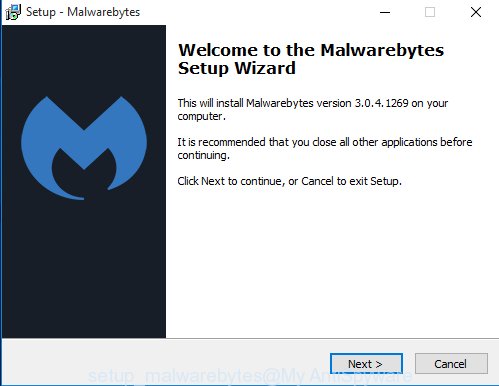
Once installation is finished, you’ll see window as displayed on the image below.
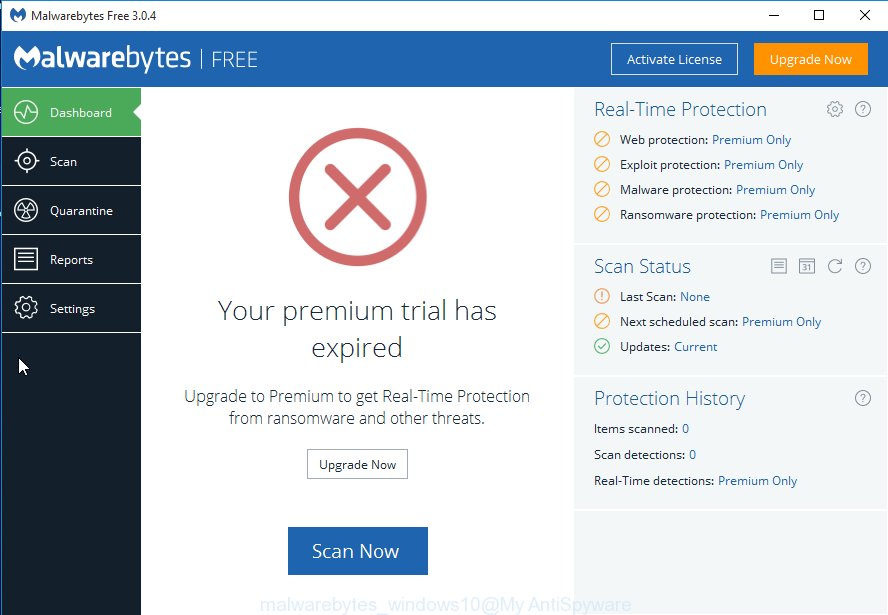
Now click the “Scan Now” button to find ‘ad supported’ software that cause misleading “Windows Has Detected a Malicious Virus” fake alerts to appear. A system scan may take anywhere from 5 to 30 minutes, depending on your personal computer. When a threat is detected, the number of the security threats will change accordingly. Wait until the the scanning is complete.
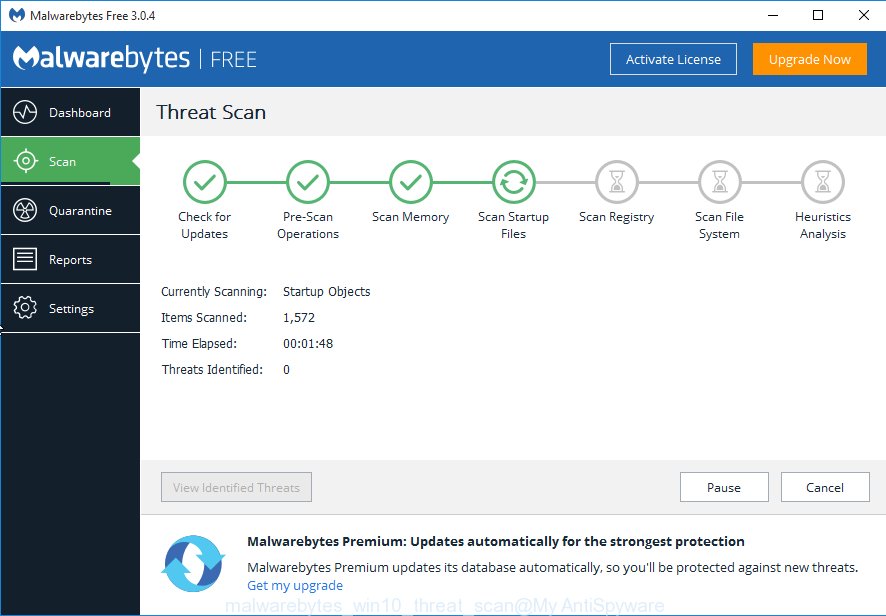
Once the checking is finished, MalwareBytes will display a screen that contains a list of malware that has been found. Make sure all items have ‘checkmark’ and press “Quarantine Selected” button.
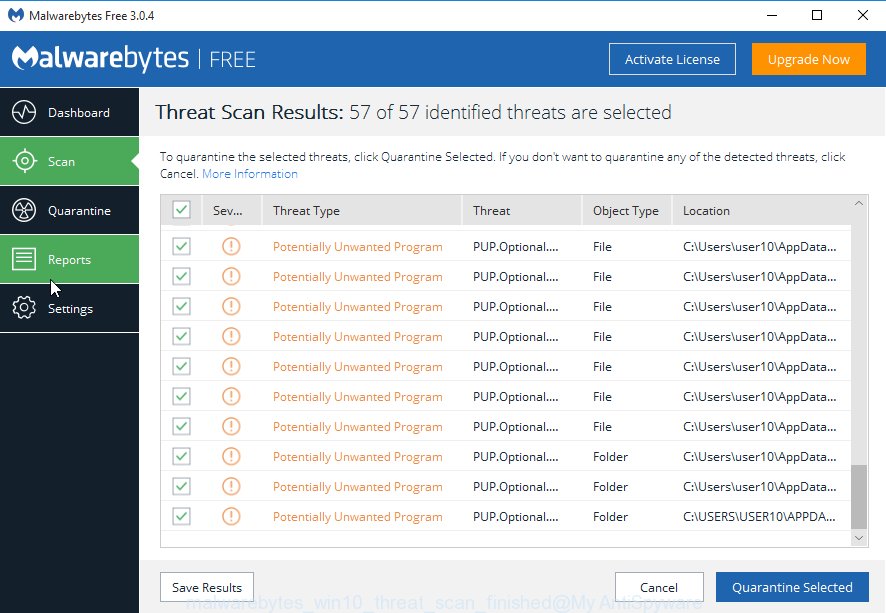
The Malwarebytes will now get rid of ad supported software that causes misleading “Windows Has Detected a Malicious Virus” pop up on your browser and move items to the program’s quarantine. When finished, you may be prompted to reboot your computer.
The following video explains step by step guide on how to delete browser hijacker, ad-supported software and other malicious software with MalwareBytes Free.
Use AdwCleaner to get rid of “Windows Has Detected a Malicious Virus” fake alerts
AdwCleaner will help get rid of ‘ad supported’ software which cause misleading “Windows Has Detected a Malicious Virus” pop-up warnings to appear that slow down your personal computer. The browser hijacker infections, adware and other PUPs slow your internet browser down and try to mislead you into clicking on suspicious advertisements and links. AdwCleaner removes the ad-supported software and lets you enjoy your PC without “Windows Has Detected a Malicious Virus” popup scam.
Click the following link to download the latest version of AdwCleaner for Microsoft Windows. Save it on your MS Windows desktop or in any other place.
225301 downloads
Version: 8.4.1
Author: Xplode, MalwareBytes
Category: Security tools
Update: October 5, 2024
Download and run AdwCleaner on your personal computer. Once started, press “Scan” button to start checking your PC for the adware that designed to show misleading “Windows Has Detected a Malicious Virus” pop up scam within your browser. A scan can take anywhere from 10 to 30 minutes, depending on the number of files on your computer and the speed of your computer. While the AdwCleaner is scanning, you may see how many objects it has identified either as being malware.. Once the scan is done, you can check all items found on your computer. Once you have selected what you want to delete from your computer, press Clean button.
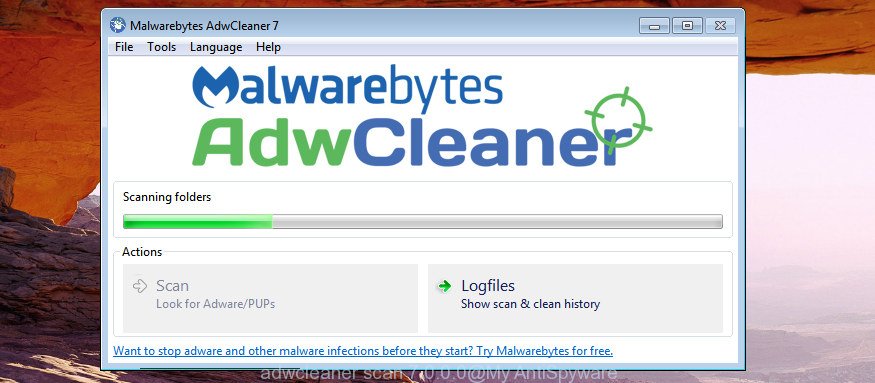
All-in-all, AdwCleaner is a fantastic free utility to free your PC from any undesired programs. The AdwCleaner is portable application that meaning, you don’t need to install it to run it. AdwCleaner is compatible with all versions of Windows OS from Microsoft Windows XP to Windows 10. Both 64-bit and 32-bit systems are supported.
Run AdBlocker to stop “Windows Has Detected a Malicious Virus” and stay safe online
Enabling an ad blocker program like AdGuard is an effective way to alleviate the risks. Additionally, ad-blocking programs will also protect you from harmful advertisements and sites, and, of course, stop redirection chain to “Windows Has Detected a Malicious Virus” and similar web-sites.
- Download AdGuard program on your Microsoft Windows Desktop by clicking on the link below.
Adguard download
26659 downloads
Version: 6.4
Author: © Adguard
Category: Security tools
Update: November 15, 2018
- Once downloading is finished, start the downloaded file. You will see the “Setup Wizard” program window. Follow the prompts.
- After the setup is finished, click “Skip” to close the installation program and use the default settings, or press “Get Started” to see an quick tutorial that will assist you get to know AdGuard better.
- In most cases, the default settings are enough and you don’t need to change anything. Each time, when you start your machine, AdGuard will run automatically and block pop-ups, web pages such “Windows Has Detected a Malicious Virus”, as well as other harmful or misleading web sites. For an overview of all the features of the program, or to change its settings you can simply double-click on the icon named AdGuard, which can be found on your desktop.
Where the “Windows Has Detected a Malicious Virus” popup comes from
The ‘ad supported’ software may be spread with the help of trojan horses and other forms of malicious software, but most commonly, the adware gets onto system by being attached to certain freeware. Many creators of free software include optional programs in their installation package. Sometimes it is possible to avoid the installation of any ad-supported software: carefully read the Terms of Use and the Software license, choose only Manual, Custom or Advanced installation option, uncheck all checkboxes before clicking Install or Next button while installing new free programs.
Finish words
Once you have finished the guidance outlined above, your PC system should be clean from ad supported software that displays misleading “Windows Has Detected a Malicious Virus” fake alerts on your PC system and other malicious software. The Chrome, Internet Explorer, Firefox and Microsoft Edge will no longer redirect you to various annoying web-sites like “Windows Has Detected a Malicious Virus”. Unfortunately, if the step by step guidance does not help you, then you have caught a new ad-supported software, and then the best way – ask for help in our Spyware/Malware removal forum.




















